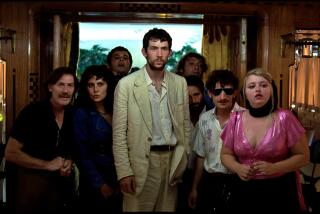Book review: ‘Paris to the Past’
Southern California residents — and most Americans outside the Northeast corridor — can only envy the speed, comfort and ease of rail travel that the French have, especially the speedy TGV (Train à Grande Vitesse). Ina Caro celebrates this mode of travel in “Paris to the Past: Traveling Through French History by Train,” as she describes a series of trips to noteworthy places that are within a few hours of the capital by rail, allowing one to explore history and the countryside by day and return to Paris for dinner.
Caro, an American who loves French history (and is the wife of biographer Robert Caro), is an unabashedly enthusiastic guide. Her love for the places she visits is contagious, although her fervor sometimes trumps other considerations.
Ina Caro argues that visiting historical sights chronologically gives the traveler an unmatched feeling for the development of French culture. Riffing on Victor Hugo’s idea that Gothic cathedrals were the equivalent of the great books of the Middle Ages, Caro discusses how the carvings and stained glass windows of Chartres Cathedral provided a way for people of all classes to understand both Bible stories and contemporary events. She reflects, “Once you look at the cathedral as a book written in stone, it becomes obvious how very important it was that the best minds of the day were expressing their thoughts in the stone at Chartres.”
Caro writes with great affection about Louis IX’s exquisite La Sainte-Chapelle on Paris’ Ile de la Cité and compares attending a concert there to “sitting inside an opulent inverted reliquary (a jewel-encrusted chest containing holy relics), in which stone has replaced precious metals and stained glass has replaced enamels and gems.” She correctly notes that the purported Crown of Thorns and other relics that La Sainte-Chapelle was built to house are no longer kept there. She doesn’t mention that the relics are nearby in Notre-Dame, where they’re displayed regularly.
Similarly, Caro’s accounts of French history sometimes feel spotty. She dislikes the “bizarre,” “transvestite” monarch Henri III and condemns him for ordering the murder of the Duc de Guise, whom she lauds as “brave, virile, handsome.” But she fails to acknowledge that her gallant duke was a religious fanatic who was plotting to overthrow the king and place himself on the throne.
She reserves her greatest enthusiasm for “my hero” Napoleon III, “because he created the Paris I love and made this book possible.” Under Napoleon III, Baron von Haussmann razed much of medieval Paris to create an achingly beautiful city of grand boulevards and scenic vistas. In her excitement, Caro dismisses such contemporary evaluations of Napoleon III as German-Prussian statesman Otto von Bismarck’s snide description, “a sphinx without a riddle,” and omits his decision to initiate the Franco-Prussian War — one of the great disasters in French history.
“Paris to the Past” needed a good editor. It’s useful to know the time it takes to reach various sites by train, but the distances are sometimes given in miles, sometimes in kilometers. Some sources are cited in the text, some at the bottom of the page, some at the end of the book. And while there are simple detail maps throughout, a comprehensive one would have been a useful addition.
Caro tends to repeat points, sometimes nearly verbatim. In a discussion of the remains of the medieval French King Philip Augustus’ castle, which form the basis of the Louvre, she explains, “At each level the towers were pierced by long slits so narrow that it was almost impossible for an attacking archer to shoot inside. From the inside, though, these slits look quite different, fanning out into pie-shaped wedges, with each arrow-slit window making the point of a triangle from which the archer inside was able to defend a wide arc outside.” A few pages later, at the fortress of Angers, she notes, “Although there is only a narrow slit outside, making it virtually impossible for those attacking the castle to hit anyone within, the archer inside has a wide triangular area in which to move about.” These repetitions make the book read like a series of collected magazine articles, rather than a unified narrative.
“Paris to the Past” is an enjoyable book that would enrich a vacation in France. Caro’s sincere enthusiasm will delight those interested in French history, but these same readers can easily see that this journey could have been a more eloquent one.
Solomon is the author, most recently, of “The Art of ‘Toy Story 3’ ” and “Tale as Old as Time: The Art and Making of ‘Beauty and the Beast.’ ”
More to Read
The biggest entertainment stories
Get our big stories about Hollywood, film, television, music, arts, culture and more right in your inbox as soon as they publish.
You may occasionally receive promotional content from the Los Angeles Times.





